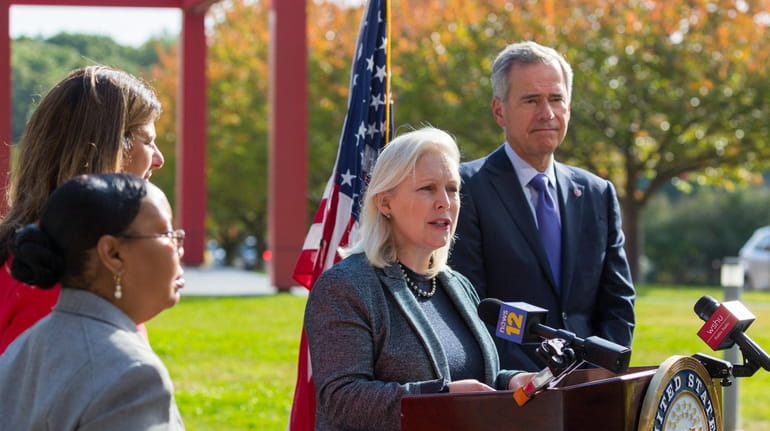Gillibrand calls for funding boost to ease health care worker shortage

Sen. Kirsten Gillibrand (D-N.Y.) announces her push to increase funding to $67 million for the Area Health Education Centers (AHEC) program during a news conference outside the Charles B. Wang Center at Stony Brook University Monday. Credit: Barry Sloan
Sen. Kirsten Gillibrand is seeking to boost funding to help train the next generation of medical professionals, including those from typically underserved communities, amid a growing health care worker shortage exacerbated by the pandemic.
Gillibrand wrote to Senate leadership Monday asking lawmakers to increase funding by at least $20 million, for a total of $67 million, in the fiscal 2022 spending bills for the Area Health Education Center program.
The 250 AHEC programs nationwide, including one that services Long Island, Queens and Brooklyn, recruits, trains and retains a diverse group of aspiring young health professionals from middle school through college, proving educational assistance, financial aid, mentoring and internships.
In a news conference Monday at Stony Brook University, Gillibrand said: "Over the last year-and-a-half our health care system and our health care providers have been at historic level of stress. They worked day and night at greater risk than ever before to meet the rising demand of health care and to keep their fellow New Yorkers healthy. They desperately need reinforcements. Staff are physically and emotionally burned out."
Even before the COVID-19 pandemic, the nation was struggling to fill a growing shortage of doctors and nurses. The pandemic exasperated this crisis, experts said, with a nationwide projected shortfall of as many as 124,000 physicians by 2034 while New York alone could be short more than 39,000 registered nurses by 2030.
That shortage, officials said, now extends to physical and occupational therapists, pharmacists, social workers, physician assistants and speech pathologists.
But the pandemic also exposed disparities in health care outcomes, with a higher proportion of Blacks and Hispanics succumbing to the virus.
Building a culturally and ethnically diverse health care workforce could improve those outcomes, said Stacy Jaffee Gropack, dean of Stony Brook University's School of Health Technology and Management.
"It's important to recognize that diversity extends to patient care outcomes," Gropack said. "Minority patients have a higher acceptance of, and trust in, the care of practitioners who are from the same race and ethnic background."
There are three regional centers and nine AHECs located across the state. During the pandemic, the Brooklyn-Queens-Long Island AHEC began a virtual program training young people how to check on homebound seniors and provide vaccine outreach, said Gabrielle Kersaint, executive director of the facility.
"We are committed to increasing the diversity of the health care professions by increasing access and opportunities for underserved and underrepresented students," Kersaint said.
There are other forces causing a health care workforce shortage. This month, Gov. Kathy Hochul announced that 3% of workers — almost 34,000 statewide — at hospitals, nursing homes, home health care agencies and adult care facilities were forced from their jobs after declining to get vaccinated against COVID.
While the vaccine mandate exacerbated an already deepening shortage in many health career careers, Gillibrand said the requirement will save lives.
"It is the wiser choice," she said.
Updated 56 minutes ago Lab results due on Bethpage drums ... Trump on trial ... Best LI high schools ... Knicks go up 2-0
Updated 56 minutes ago Lab results due on Bethpage drums ... Trump on trial ... Best LI high schools ... Knicks go up 2-0

